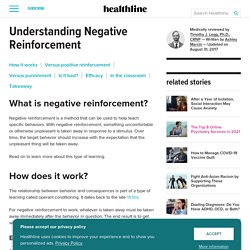

Positive reinforcements are used when a stimuli is added to the reinforcement in order to reward the child. an example of positive reinforcement would be to allow the child added mobile privileges after good behaviour. Negative reinforcers are not bad. Instead, they are unwanted or unpleasant stimuli that are taken away from the child following good behaviour. Such an example would be to remove strict parental controls on the tv when the child exhibits responsible behaviour.
Punishments too are positive and negative. A positive punishment is an attempt to change a child's behaviour by adding a stimuli that is unpleasant to the child. An example of this would be to spank a child for misbehaving. A negative punishment would on the other be removing a stimuli to punish the child. An example of this would be grounding the child by taking away his/her privileges.
#positivereinforcement
#negativereinforcement
#punishementinchildren
#positivepunishment
#negativepunishment.
Using Positive Reinforcement. Positive reinforcement for children. Changing your two years old behaviour. Negative Reinforcement: What Is It and How Does It Work? What is negative reinforcement?

Negative reinforcement is a method that can be used to help teach specific behaviors. With negative reinforcement, something uncomfortable or otherwise unpleasant is taken away in response to a stimulus. Over time, the target behavior should increase with the expectation that the unpleasant thing will be taken away. Negative reinforcement: Definition and examples. Negative reinforcement encourages specific behaviors by removing or avoiding negative consequences or stimuli.

It is different than punishment, which aims to discourage a specific behavior. Negative reinforcement has become a popular way of encouraging good behavior at school. Keep reading to learn more about how it works and how it differs from positive reinforcement and punishment. Negative reinforcement is the encouragement of certain behaviors by removing or avoiding a negative outcome or stimuli. People typically use this technique to help children learn good patterns of behavior, but it can also play a role in training animals and pets.
Positive Punishment: What Is It And How It Works? - MomJunction. Positive punishment!

Sounds like a perfect oxymoron. But how can a punishment be positive? How can you even enforce such a punishment? Is it effective? Before many such questions crop in your mind, let us explain what we are going to tell you in this post. What Is 'positive Punishment'? Definition And Real-World Examples. Positive punishment is a popular concept in parenting.

We'll explain what it is and how you can implement it with six examples. Parenting isn't always a walk in the park, and determining the best way to address your child's inevitable poor behavior can be a tricky line to walk. Techniques like positive punishment and negative reinforcement (two parenting "buzzwords" that you've probably heard a lot already) are just two of the ways parents and child care providers can try to correct a child's behavioral issues. [RELATED: "Parenting Styles: 4 Negative Reinforcement Examples "] What Is Negative Punishment. Operant Conditioning - Negative Reinforcement vs Positive Punishment.